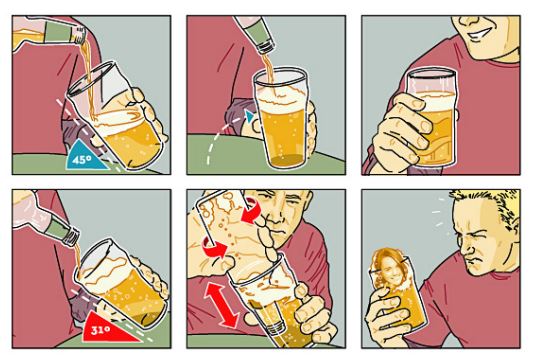The perfect beer pour is a matter
of some debate; in the United States and in
Southern England, we typically prefer a small
amount of head with the maximal amount of beer
whereas in other areas of Europe, a beer should be
served with a large froth head, and in other areas
still, the amount of head is dictated by the type
and style of beer. One thing that is agreed upon,
however, is that the angle over which the beer is
poured is an essential component in ensuring that
the beer's froth (and thus taste) is optimal.
 Image Source: The
Perfect Pour: Beer Foam Physics and the Art of
Dispensing Beer
Image Source: The
Perfect Pour: Beer Foam Physics and the Art of
Dispensing Beer
Generally the beer should be
poured (regardless of whether from tap, can, or
bottle) with the glass held at approximately 45˚
initially and gradually shifting to
perpendicular to a table or flat surface on
which to rest. The reason fore the initial
angled tilt of the glass is to promote a greater
surface area of liquid to wash over the glass,
which in turn allows a greater amount of CO2 to
fall out of solution of the brew. This action
also reduces the final velocity with which the
fluid will impact the bottom of the glass,
thereby minimizing the buildup of froth which
will prevent the beer from becoming "too heady
too quickly." From there, the angle is adjusted
to a straight pour to promote the formation of
beer head to taste.
One may consider the
angle of a beer pour essential in controlling
the vorticity of the fluid; in fluid dynamics,
vorticity is a vector quantity which tells us
the tendency of a fluid particle to rotate about
a particular point. Vorticity is given by the
equation:
where
is the curl of the of the fluid, V is
the flow velocity, and
is the del operator. In minimizing the overall
fluid vorticity, one minimizes the agitation of
the fluid particles, and thus directly minimizes
the amount of CO2 falling out of brew solution.
As such, the angle plays the greatest role in
controlling the vector agitation of beer
particles.
|